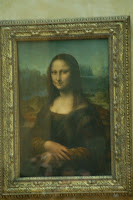
While looking for post topics for today, I found out that today is the anniversary of the opening of the Louvre as a public museum in 1793. Since I visited there on my recent trip (and got hopelessly lost in their majorly twisty corridors, but that’s another story…), I thought it would be fun to find out more about its development from palace to vast museum! (FYI, the Louvre contains more than 380,000 objects, ranging from the 6th century BC to the 19th century, with 35,000 on display in more than 650,000 square feet. It averages 15,000 visitors a day, and employs more than 2000. In 1986, with the completion of the Musee d’Orsay, objects from after 1848 were moved there and the collection was split)
 The Louvre started in the 12th century, as a fortress built by Phillipe II. Remnants of the fortress are still visible in below-ground galleries. The building was then extended several times, until in 1674 Louis XIV moved his court to the Palace of Versailles, leaving the Louvre mainly as a place to display some of the royal collections. During the Revolution, the National Assembly decreed the former palace a museum of the people (“a place for bringing together monuments of the arts and sciences”). It opened with an exhibit of 537 paintings, most of them seized from royal and Church property.
The Louvre started in the 12th century, as a fortress built by Phillipe II. Remnants of the fortress are still visible in below-ground galleries. The building was then extended several times, until in 1674 Louis XIV moved his court to the Palace of Versailles, leaving the Louvre mainly as a place to display some of the royal collections. During the Revolution, the National Assembly decreed the former palace a museum of the people (“a place for bringing together monuments of the arts and sciences”). It opened with an exhibit of 537 paintings, most of them seized from royal and Church property.
The public was given free access three days a week, but the building was closed in 1796 due to “structural deficiencies,” and not re-opened until 1801, with displays now arranged chronologically and organized with new columns and lighting.
 Under Napoleon, the collections expanded greatly, thanks to works sent back from Egypt, Spain, Austria, Holland, and Italy. After his defeat at Waterloo, many former owners sought their return, which the Louvre’s administrators were, er, reluctant to comply with. In response, many of the restored foreign powers sent diplomats to seek out these works and secure their return. (An echo of this was seen just before World War II, when, on August 27, 1939, a long truck convoy left Paris taking countless objects and paintings to new hiding spots. By December, the museum was entirely cleared except for items too heavy or “insignificant” to be moved. In 1945, the art came back).
Under Napoleon, the collections expanded greatly, thanks to works sent back from Egypt, Spain, Austria, Holland, and Italy. After his defeat at Waterloo, many former owners sought their return, which the Louvre’s administrators were, er, reluctant to comply with. In response, many of the restored foreign powers sent diplomats to seek out these works and secure their return. (An echo of this was seen just before World War II, when, on August 27, 1939, a long truck convoy left Paris taking countless objects and paintings to new hiding spots. By December, the museum was entirely cleared except for items too heavy or “insignificant” to be moved. In 1945, the art came back).
 The Louvre is best known for objects such as the Venus de Milo, Nike of Samothrace, the Apollo Belvedere, Michelangelo’s “Slaves” sculptures, David’s Coronation of Napoleon (I stood in front of this for a long time studying the gowns!), Delacroix’s Liberty Leading the People, Vermeer’s The Lacemaker, and of course Mona Lisa.
The Louvre is best known for objects such as the Venus de Milo, Nike of Samothrace, the Apollo Belvedere, Michelangelo’s “Slaves” sculptures, David’s Coronation of Napoleon (I stood in front of this for a long time studying the gowns!), Delacroix’s Liberty Leading the People, Vermeer’s The Lacemaker, and of course Mona Lisa.
Some good sources to read more about the Louvre are Andrew McClellan’s Inventing the Louvre; Bette Wynn Oliver’s From Royal to National: The Louvre Museum and the Bibliotheque National; and Alain Nave’s Treasures of the Louvre.
 What are some of your favorite museums, or works of art? What would you do if you were lost in the Louvre???
What are some of your favorite museums, or works of art? What would you do if you were lost in the Louvre???
And be sure and join us tomorrow, as we discuss the Harlequin Historicals anthology One Candlelit Christmas, just as the holiday season gets started!
(And also don’t forget that the Harlequin Historical Undone stories are only .89 at eharlequin for November!! Check The Good The Bad The Unread for reviews of all 4 stories…)





 he great turning point for the Regency was the French revolution. Just as we feel now, that history has been made and a new era is beginning, people then might remember where they were when they heard about the fall of the Bastille. The French revolution was the wakeup call of its day, a source of inspiration and hope.
he great turning point for the Regency was the French revolution. Just as we feel now, that history has been made and a new era is beginning, people then might remember where they were when they heard about the fall of the Bastille. The French revolution was the wakeup call of its day, a source of inspiration and hope.



















